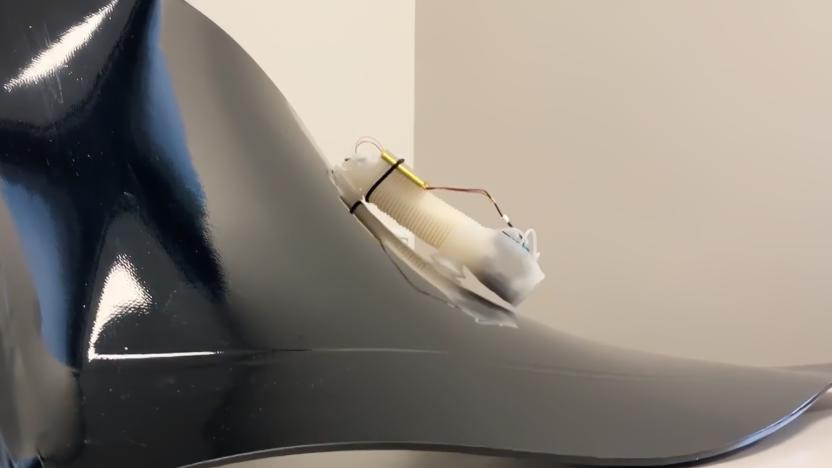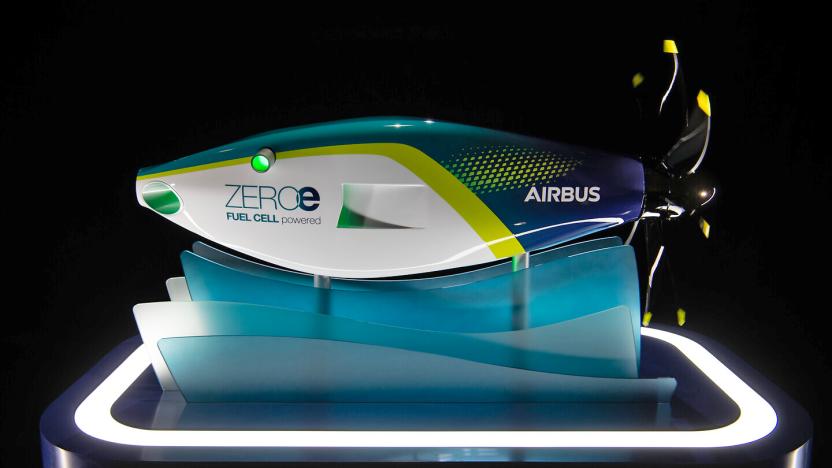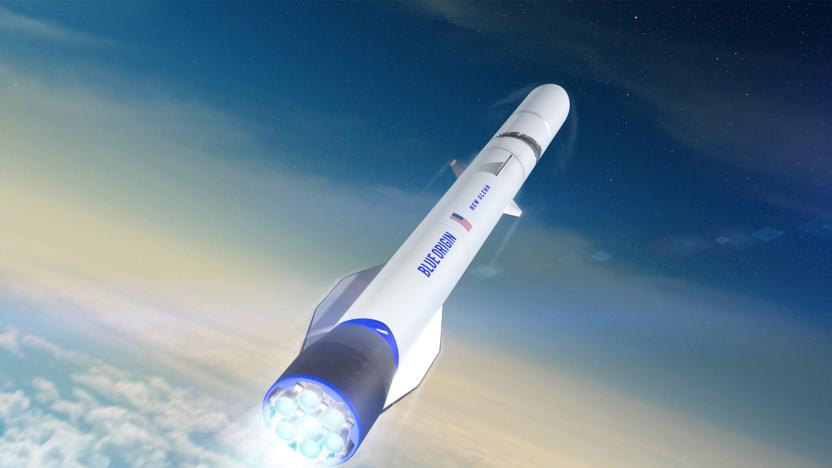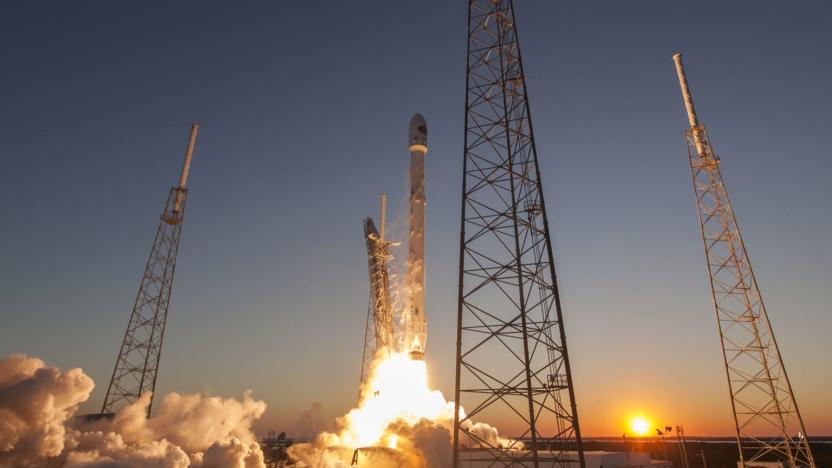engine
Latest

GE Aerospace is developing a robotic worm to inspect and repair jet engines
GE Aerospace has demonstrated a worm-like robot that could one day inspect and repair jet engines. The Sensiworm (Soft ElectroNics Skin-Innervated Robotic Worm) is designed to serve as “extra sets of eyes and ears” for service engineers and mechanics as they examine the insides of engines.

Airbus is building a hydrogen fuel-cell engine for aircraft
As part of its goal to have zero-emission aircraft enter service by 2035, Airbus has announced the development of a hydrogen fuel-cell engine designed to for airplanes.

Unity is offering premium game development tutorials for free
Unity, arguably the biggest game engine in the world, is giving away hundreds of hours of premium game developing tutorials for free because of the coronavirus. For three months until June 20th, aspiring game makers will be able to get their hands on courses on everything from coding to design, and get access to Unity's daily interactive live lessons, Create with Code.

IndyCar will switch to 900-horsepower hybrid race cars in 2022
IndyCar just announced plans to get a little greener. Beginning in 2022, its race cars will be hybrids. They'll use a combination of internal combustion engines from Honda and Chevrolet and a hybrid system to produce somewhere in the ballpark of 900 horsepower. In comparison, current IndyCars race at between 500 and 700 horsepower.

Blue Origin starts building the factory for New Glenn's engines
Blue Origin's New Glenn rocket just became more tangible. The company has officially started construction on a factory in Huntsville, Alabama that will produce the BE-4 engines powering both New Glenn and United Launch Alliance's Vulcan Centaur. It'll also make the BE-3U engines used for New Glenn's second stage. While it's not clear when the factory will start making rockets, Blue Origin expects to complete development later in 2019.

US government accuses Chinese hackers of stealing jet engine IP
The Justice Department has charged ten Chinese nationals -- two of which are intelligence officers -- of hacking into and stealing intellectual property from a pair of unnamed US and French companies between January 2015 to at least May of 2015. The hackers were after a type of turbofan (portmanteau of turbine and fan), a large commercial airline engine, to either circumvent its own development costs or avoid having to buy it. According to the complaint by the Department of Justice, a Chinese aerospace manufacturer was simultaneously working on making a comparable engine. The hack afflicted unnamed aerospace companies located in Arizona, Massachusetts and Oregon.

Jeff Bezos' Blue Origin beats key rival to rocket engine deal
Blue Origin is best known for its own rocket programs, but it just scored a deal that could make it an important name in the spaceflight industry. United Launch Alliance has chosen Blue Origin's BE-4 engine (two of them, to be exact) to power the booster stage its next-generation Vulcan Centaur rocket, which is due to launch in mid-2020. Jeff Bezos' outfit won't be the only rocket vendor involved, but it crucially beat out Aerojet Rocketdyne -- a behemoth in the industry that had tried to pressure ULA into avoiding Blue Origin tech altogether.

Rolls-Royce may use bug-like robots to assist airplane engine repair
Rolls-Royce showed off a handful of small robots this week that could aid in the inspection and repair of airplane engines sometime in the future. Though still under development, the tiny robots could lead to faster, less labor-intensive engine inspections as well as cost reductions for engine maintenance. The technologies, which were displayed at the Farnborough Airshow, are being developed in partnership with other companies as well as researchers at the University of Nottingham and Harvard University.

SpaceX’s Falcon Heavy launch has been pushed to next year
SpaceX's Falcon Heavy rocket has been gearing up for its inaugural launch for quite some time, but multiple delays keep pushing that event later and later. The SpaceX team had most recently been shooting for a launch before the end of this year, but according to reports from Aviation Week and confirmed to us by SpaceX, Falcon Heavy probably won't see a launch before next year.

A SpaceX rocket engine exploded during a 'qualification test' in Texas
SpaceX was testing a rocket engine on Sunday when it exploded, and now the aerospace company is trying to figure out what happened. The incident happened at a company site in Texas, and SpaceX reported no injuries and doesn't expect that the accident will affect its launch schedule.

Mazda's engine breakthrough promises big fuel efficiency gains
Mazda has made the announcement car manufacturers have been working towards for years: it's releasing the first commercial compression-ignition gasoline engine. Dubbed SkyActiv-X, the engine will be available in 2019 and promises up to 20-30% more engine efficiency than the current SkyActiv-G, and up to 45% more than Mazda's 2008 petrol engine. Current gasoline engines rely on a spark plug to ignite their air-fuel mix. The SkyActiv-X will ignite the air-fuel mix spark-free through compression, like a diesel engine. This, according to the Japanese manufacturer, combines the advantages of petrol and diesel engines to achieve "outstanding" environmental and power performance.

MIT fires a rocket motor made using 3D-printed plastic
If you're going to 3D-print rocket parts, you'd want to make them out of metal to handle the stress, right? Not necessarily. MIT has successfully test-fired what it believes is the first completely 3D-printed rocket motor to be made with plastic casing. That's right -- an all too easily melted material was sitting a virtual hair's breadth away from super-hot propellant. It sounds like a recipe for disaster, but apparently it worked well -- it generated real thrust, and there was only a small amount of damage to the motor's throat after the initial run. A second test didn't fare so well (it would be useless for moving anything), but MIT hadn't intended for the motor to fire more than once.

After Math: Keep pace in the space race
It's been a productive week for those of us trying to get the hell off this crazy planet. NASA showed off a radiation-proof flight vest for interplanetary astronauts while Blue Origin debuted its latest rocket engine and previewed its upcoming New Glenn spacecraft. We also take a look at a solar farm visible from the ISS and examine just how badly the Trump regime is gutting NASA's Earth Science programs. Numbers, because how else will we know when it's time to blast off?

NASA demonstrates EM Drive theory, but don't get too excited
A fuel-free engine is the stuff of science fiction for now, but scientists at NASA Eagleworks have published a peer-reviewed paper that suggests the ideas behind an EM Drive are worth testing further. Researchers at Eagleworks, a small NASA team tasked with testing humanity's wildest theories of spaceship propulsion, were able to produce thrust without any kind of propellant, in a vacuum, as they published this weekend in ARC.

ICYMI: Orbital space junk is putting us in jeopardy
try{document.getElementById("aol-cms-player-1").style.display="none";}catch(e){}Today on In Case You Missed It: The US Air Force is moving its Space Surveillance Telescope to Australia to track space junk littering geosynchronous orbit. That's the orbit 22,000 miles away from our planet where satellites mirror the Earth's rotation so that they don't appear to move. The Department of Justice story about facial recognition is here, while that darling sneezing baby (who eschews costumes) is here. If you enjoy the cartoon humor that is an engine giving up on a job, that's here. As always, please share any interesting tech or science videos you find by using the #ICYMI hashtag on Twitter for @mskerryd.

Microsoft's speech recognition engine listens as well as a human
When humans try to transcribe a spoken conversation all in one go, they manage to miss 5.9 percent of what they hear on average. Microsoft announced on Tuesday that, for the first time, they've managed to get a computer to perform that same transcription task just as well as a person. "We've reached human parity," Microsoft's chief speech scientist Xuedong Huang, said in a statement.

Russia hopes 'clean' rockets are the future of spaceflight
If you ask Russia, modern rockets are hindered by not just their engines, but their fuel -- the chemicals just aren't powerful enough to carry increasingly heavier loads and keep costs in check. To that end, the country's Advanced Research Foundation has conducted what it says is the first successful test of a full-size pulse-detonation engine (where rapid-fire detonation waves combust the fuel and oxidizer) running "clean" fuel. The oxygen-kerosene mix isn't so much eco-friendly (although it does burn more cleanly) as very efficient. Its high thermodynamic performance, combined with the extra efficiency of pulse-detonation itself, would let rockets either carry more cargo into space or reduce costs by getting vehicles into orbit faster.

Infiniti's latest engine is a last hurrah for gas-powered cars
Hybrid and pure electric cars may be the future of transportation, but Nissan's Infiniti badge has found a way to make the most out of gas engines while they're still relevant. When the next-generation QX50 crossover arrives in 2017, it'll carry the first-ever production variable compression turbo (VC-T) engine -- a technology that promises to dramatically improve fuel efficiency without compromising on performance. By automatically adjusting the height the engine's pistons reach, the VC-T motor can optimize its compression ratio for the task at hand. It'll lower the ratio if you're mashing the throttle (to prevent premature detonation and make the most of the turbo), but raise it when you're putting around town and need to wring out better mileage.

SpaceX to start testing the engine that will take it to Mars
SpaceX has recently inched closer to realizing its head honcho's -- that's Elon Musk, but you already know that -- ambitious Mars plans. It has sent its next-generation rocket engine, the one it's developing for the rocket that will ferry a spacecraft to the red planet, to its McGregor, Texas facility for testing. Company president Gwynne Shotwell made that revelation during the Small Satellite Conference in Utah. A spokesperson also confirmed to Ars Technica that the engine is being prepped for testing in the Lone Star State.

Honda unveils first hybrid motor without heavy rare earth metals
Honda pledged to reduce its use of rare earth metals a decade ago, and the automaker took another step towards that goal this week. It unveiled its new hybrid motor that was co-developed alongside Daido Steel, another Japan-based company. The new motor doesn't use heavy rare earth metals like dysprosium and terbium, instead relying on magnets from Daido Steel that cost 10 percent less and weigh 8 percent lighter than the previous components. In fact, the automaker is the first to develop a hybrid motor that doesn't use the heavy metals. Honda says the new engines will reduce its reliance on the pricey rare earth metals that are primarily supplied by China.











